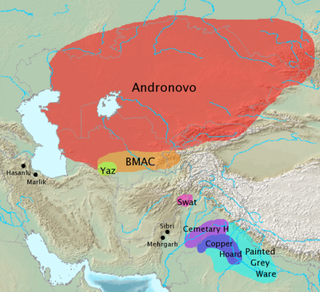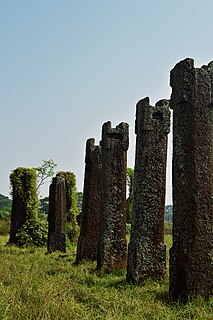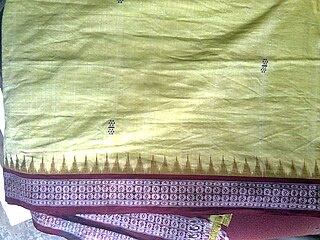
Terra sigillata is a term with at least three distinct meanings: as a description of medieval medicinal earth; in archaeology, as a general term for some of the fine red Ancient Roman pottery with glossy surface slips made in specific areas of the Roman Empire; and more recently, as a description of a contemporary studio pottery technique supposedly inspired by ancient pottery. Usually roughly translated as 'sealed earth', the meaning of 'terra sigillata' is 'clay bearing little images', not 'clay with a sealed (impervious) surface'. The archaeological term is applied, however, to plain-surfaced pots as well as those decorated with figures in relief.

Berhampur also known as Brahmapur is a city on the eastern coastline of Ganjam district of the Indian state of Odisha in East India.

The Ochre Coloured Pottery culture (OCP) is a 2nd millennium BC Bronze Age culture of the Indo-Gangetic Plain, extending from eastern Punjab to northeastern Rajasthan and western Uttar Pradesh. It is considered a candidate for association with the early Indo-Aryan or Vedic culture.
This article lists monuments and sites of historic importance in Odisha, India.

Pushpagiri was an ancient Buddhist mahavihara located atop Langudi Hills in Jajpur district of Odisha, India. The complex contains ruins of stupas, rock-cut sculptures and other artifacts.

Pottery and ceramics have been produced in the Levant since prehistoric times.

Jaugada is a ruined fortress in the Ganjam district in Odisha, India. Jaugada lies 35 km north-west of Berhampur and 160 km south-west of Bhubaneshwar. Once a provincial Mauryan fortified capital of the newly conquered province of Kalinga, Jaugada is famed by its version of the monumental stone-cut edicts in Prakrit of the Mauryan emperor Ashoka.

Sisupalgarh or Sisupalagada are a ruined fortification in Khurda District in Odisha, India. It is one of the largest and best preserved early historic fortifications in India.

Sankarjang, Odisha, India is an archaeological site near Angul, a former cemetery and settlement with large, worked stones but no one knows what they were made for, although some people think they might have been part of a lithophone. This site was test excavated by the State Archaeology Department of Odisha after a chance find of 20 long unfinished chipped and ground, lithic bars and axes of basalt, together with human skeletal remains and metallic artifacts, by a shepherd in 1971.

Siswal is a village in Hisar district, Haryana, India. It is a site of Chalcolithic age. It is a typesite for Siswal culture dating around 3800 BC, also known as Sothi-Siswal culture.

Daimabad is a deserted village and an archaeological site on the left bank of the Pravara River, a tributary of the Godavari River in Shrirampur taluka in Ahmednagar district of Maharashtra state in India. This site was discovered by B. P. Bopardikar in 1958. It has been excavated three times so far by the Archaeological Survey of India teams. The first excavation in 1958-59 was carried out under the direction of M. N. Deshpande. The second excavation in 1974-75 was led by S. R. Rao. Finally, the excavations between 1975-76 and 1978-79 were carried out under the direction of S. A. Sali. Discoveries at Daimabad suggest that Late Harappan culture extended into the Deccan Plateau in India. Daimabad is famous for the recovery of many bronze goods, some of which were influenced by the Harappan culture.

Bomkai Sari is a handloom saree from Odisha, India. It is an origin of Bomkai, Ganjam district in the state and is primarily produced by the “Bhulia” community of Subarnapur district. Bomkai is one of the identified Geographical Indications of India. Sonepur handloom sarees, Sonepuri paatas and silk sarees are popular items displayed at various fashion shows.
The history of Kalahandi goes back to the primitive period where a well-civilized, urbanized, and cultured people inhabited this land mass around 2000 years ago. The world's largest celt of Stone Age and the largest cemetery of the megalithic age have been discovered in Kalahandi. This shows the region had a civilized culture since the pre-historic era. Asurgarh near Narla in Kalahandi was one of the oldest metropolises in Odisha whereas the other one was Sisupalgarh near Bhubaneswar. Some other historical forts in the region includes Budhigarh, Amthagarh, Belkhandi and Dadpur-Jajjaldeypur. This land was unconquered by the great Ashoka, who fought the great Kalinga War, as per Ashokan record. In medieval period the region had played a prominent role to link South India, Eastern India and Central India region and witnessed the battle ground for Somavamsi, Chola, Kalachuris of Kalyani and Eastern Ganga dynasty. Kalahandi region was the main route for Chola to attack Subarnapur.

Manikpatna is an archeological site in the state of Odisha in eastern India. It has been identified with the medieval port of Chelitalo described by the Chinese pilgrim Hiuen Tsang. The site is on the left bank of the Kushabhadra river, at the northern end of the Chilika Lake.

Asurgarh is an archaeological site in the Kalahandi district of Odisha.

Inamgaon is a post-Harappan agrarian village and archaeological site located in Maharashtra, western India. Situated along the right bank of the Ghod River, it is considered to be the 'regional centre' of the Bhima Valley.
Larnaca District Museum is a museum in Larnaca, Cyprus that has displays that show the "historical development of the city of Kition and the District of Larnaka in general." It was inaugurated in 1969. and was formerly named Larnaca District Archaeological Museum. It is controlled by the Department of Antiquities.

Odisha Ikat is a kind of ikat, a resist dyeing technique, originating from Indian state of Odisha. Also known as "Bandha of Odisha", it is a geographically tagged product of Odisha since 2007. It is made through a process of tie-dying the warp and weft threads to create the design on the loom prior to weaving. It is unlike any other ikat woven in the rest of the country because of its design process, which has been called "poetry on the loom". This design is in vogue only at the western and eastern regions of Odisha; similar designs are produced by community groups called the Bhulia, Kostha Asani, and Patara. The fabric gives a striking curvilinear appearance. Saris made out of this fabric feature bands of brocade in the borders and also at the ends, called anchal or pallu. Its forms are purposefully feathered, giving the edges a "hazy and fragile" appearance. Ikat's equivalent usage in Malay language is mengikat, which means "to tie or to bind".
Jebel al-Salayli, is an archaeological site in the Sharqiyah province of the Sultanate of Oman, where a large number of Early Iron Age so-called hut tombs were first mentioned publicly. The first citation mistakenly refers to this site as 'Musfa', a site which actually lies a few kilometres to the north. The Jebel is the adjacent mountain to the immediate north. The Jebel al-Salayli site attracted the attention of archaeologists because of an abandoned copper mine, extensive slag fields, ruined settlements and numerous Early Iron Age tombs. Nestled between the mountains, this site is still relatively well preserved. The settlement ruins date to the Early Iron Age and the Muslim Period. At the lower end of a wadi, the hut tombs, designated stie 1, lie 400 m west of an abandoned copper mine, to which they probably originally owed their existence.



















